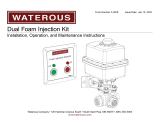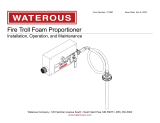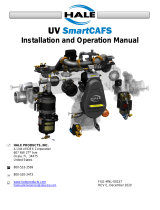Page is loading ...

Table of Contents
Safety 4
Safety Precautions 4
Introduction 6
Using this Document 6
Viewing the Document Electronically 6
Printing the Document 6
Additional Documentation 6
Product Overview 8
AQUIS ULTRAFLOW Industrial Foam Proportioner System 8
Discharge Line Assemblies and Valves 12
2-Inch High-Flow DLA and Transmitter 14
2-Inch DLA Assembly 16
1-Inch DLA Assembly 18
1-Inch Low-Flow Bypass Line Assembly 20
Priming Valve Assembly 22
Paddlewheel Flowmeter 24
Line Pressure Transducer 26
Terminating Resistor 27
Y-Splitter 28
Split CANbus Cable 29
2.0 Meter CANbus Extension Cable 30
0.5 Meter CANbus Extension Cable 31
3.0 Meter Sensor Cable 32
0.5 Meter Sensor Cable 33
0.5 Meter Pressure Transducer Cable—Alternate Discharge Pressure Measurement 34
CANbus Valve Motor Cable 35
Priming Valve Motor Cable 36

Installation 38
Installation Overview 38
Preparing for the Installation 38
Modifying the Equipment 38
Optional Equipment 38
Determining DLA and Valve Locations 39
Determining Cable and Wire Routing 39
Plumbing Layout 40
Installing the DLA Identication Labels 42
DLA Components and Connections 44
CANbus Cables and Connections 45
Connecting the 1-Inch DLA 46
Connecting the 2-Inch DLA 47
Connecting the Priming Valve 48
Connecting the Low-Flow Bypass Line 49
Connecting the Supply Tank Fill Line 50
Connecting the Y-Splitter—Alternate Discharge Pressure Measurement 51
Installing the Transmitter and Flowmeter 52
Wiring the Transmitter and Flowmeter—Custom Cable Length Application 53
X1 Cable Schematic—Custom Cable Length Application 54
X2 Cable Schematic—Custom Cable Length Application 54
Operation 55
Operation Overview 55
Preparing for the Operation 55
During Operation 55
After Operation 55
Relling the On-Board Supply Tank—Screen View 58
Understanding Priming 60
Understanding Over-Pressure Events 60
Manually Priming the Concentrate Line—with Concentrate 61
Manually Priming the Concentrate Line—with Water 62
Transferring Concentrate 63
Relaying Concentrate 64
Flushing the Apparatus Plumbing 65
Maintenance 66
Maintenance Schedule 66

4 | 68
Safety Precautions
• Read and understand all the associated documentation before you begin the
installation.
• Read and understand all the notices and safety precautions.
• Be aware that these instructions are only guidelines and are not meant to be
definitive. Contact Waterous when you have questions about installing,
operating, or maintaining the equipment.
• Do not install the equipment if you are not familiar with the tools and skills
needed to safely perform the required procedures—proper installation is the
responsibility of the purchaser.
• Do not operate the equipment when safety guards are removed.
• Do not modify the equipment.
• Regularly check for leaks and worn or deteriorated parts.
• Discharge ejected at high
pressure can cause serious
injury and damage.
High Pressure
• Direct discharge away from
people and equipment.
NOTICE
Modifying the equipment
can damage components
and void your warranty.
•
Do not modify the system
or any of its components.
•
Modification
NOTICE
Before Operation
• Read and understand all
the instructions provided.
• Check all fluid levels
and replenish if necessary.
• Remove all shipping plugs
and install the operation
plugs or caps.

5 | 68
Safety Precautions
NOTICE
Do not allow fluid in the
lines to freeze.
•
Remove all freezable fluid
from the lines before
storing the apparatus.
•
Freeze Damage
NOTICE
Priming with water can
contaminate the on-board
concentrate supply.
•
Divert water to prevent
concentrate contamination.
•
Concentrate Supply
Contamination

6 | 68
Use this document to install and operate your Waterous equipment. Understand
the following conditions before continuing with the document:
• The instructions may refer to options or equipment that you may not have
purchased with your system.
• The illustrations in this document are intended to convey concepts. Do not
use the illustrations to determine physical attributes, placement, or
proportion.
• Understand that your application may require additional steps, that are not
described in the illustrations or instructions, to perform the installation.
• The equipment described in this document is intended to be installed by a
person or persons with the necessary skills and knowledge to perform the
installation.
• The equipment described in this document is intended to be operated by a
person or persons with the basic knowledge of operating similar equipment.
• The information in this document is subject to change without notice.
This document is divided into the following sections:
This section describes general precautions and alert symbols that are in this
document.
This section is an overview of the document.
This section describes the components that make-up the system.
This section describes the installation and initial setup procedures.
This section describes the equipment operation.
This section describes any required maintenance.
Using this Document
Use the guidelines below when viewing this document.
Viewing the Document Electronically
• View this document in landscape orientation.
• Use the table of contents to navigate directly to that section.
• Tex t with this appearance is linked to a reference.
Printing the Document
• The document is viewed the best when printed in color.
• The print on both sides and flip on long edge features can provide the
best results.
• Use a 3-ring binder to store the document.
Additional Documentation
Additional documentation is available through the MyWaterous login at
Waterousco.com. Use your serial number to gain access to the service parts
list associated with your system. Dimensional drawings are available through
the Waterous Service department.

Notes
7 | 68

9 | 68
AQUIS ULTRAFLOW Industrial Foam Proportioner System
The AQUIS ULTRAFLOW industrial foam proportioner system supplies concentrate into a solution-capable discharge line. A Tellurus™ touchscreen display, or
human machine interface (HMI), shows system activity, and provides control over the system using a CANbus protocol. Foam concentrate is sourced from an
on-board supply tank or an auxiliary source. The concentrate pump distributes concentrate though the discharge line assembly (DLA) using hydraulic
components, where it is measured, controlled, and introduced into the solution-capable discharge line to produce foam solution. Understand that your application
will include all or portions of the components described.
SubsystemSubsystem DescriptionDescription
1Control system This monitors and controls the foam proportioning system. The components in this subsystem include:
• Tellurus display (HMI)—this displays system operation and provides control of the system.
• Control box—this connects to various components in the system and contains the programmable logic controllers (PLC).
• Manual override switch—this disables the automatic control of the concentrate control valves.
• Power disconnect relay—this power relay enables and disables power to the DLA.
• Remote I/O—this adds a node controller to the system for additional options required in your application.
• Various cables—these provide communication and power to system components.
2 Discharge line assembly This manages the concentrate injected into the solution-capable discharge. The system can control up to 19 DLAs. The
components in this subsystem include:
• Node controller—this connects to, and controls, the concentrate control valve, reads the owmeters and the discharge
pressure transducer.
• Split CANbus cable—this connects the node controllers to one another and the control box.
• DLA terminating resistor—this terminates the CANbus connection on the last node controller or valve in the CANbus
chain.
• Concentrate control valve—this controls the concentrate flow.
• Magnetic flowmeter—this measures the concentrate flow.
• Check valve—this prevents contamination of concentrate by preventing reverse fluid flow in the line.
• Cal/Inject valve—this allows you to divert and collect water or concentrate when calibrating the your system.
3Solution-capable discharge This includes the installer-supplied water pump, distribution manifold, plumbing, and additional components that produce
water flow. Additional components in this subsystem include:
• Paddlewheel flowmeter—this measures the amount of water flowing in the discharge. Note: You can install the
• Water pump pressure transducer—this measures the pressure at the pump discharge. Note: Some applications prohibit
• Solution discharge pressure transducer—this measures the pressure at the solution capable discharge.

10 | 68
AQUIS ULTRAFLOW Industrial Foam Proportioner System
SubsystemSubsystem DescriptionDescription
4Concentrate pump These components support, control, and power the concentrate pump. The components in this subsystem include:
• Concentrate pump—this circulates the foam concentrate through the system.
• Hydraulic motor—this drives the concentrate pump.
• Hydraulic pump—this drives the hydraulic motor.
• Hydraulic fluid reservoir—this contains the hydraulic fluid supply.
• Hydraulic fluid filter—this filters the hydraulic fluid.
• Hydraulic fluid heat exchanger—this cools the hydraulic fluid.
• Hydraulic fluid temperature sensor—this measures the hydraulic fluid temperature.
• Hydraulic fluid level sensor—this monitors the hydraulic fluid level in the reservoir.
• Pressure transducer—this measures the pressure in the concentrate discharge line.
• Pressure relief valve—this limits the pressure in the concentrate discharge manifold by opening when the pressure
reaches a predetermined level.
5Concentrate supply This contains components that contain or supply foam concentrate for the system. The components in this subsystem
include:
• Concentrate supply tank—this contains the on-board foam concentrate supply.
• Tank-full sensor—this indicates a tank full condition to the system.
• Tank-low sensor—this indicates a tank low condition to the system.
• Tank level sensor—this is an installer supplied sensor and display that indicates the supply level in the tank.
• Concentrate pump intake select valve—this is an installer supplied, 2 position valve, and additional components that
sources concentrate from an on-board tank or an auxiliary supply. A signal is provided to the system to ignore the
on-board tank sensors when sourcing concentrate from an auxiliary supply.
• Concentrate strainer—this collects debris that would otherwise flow through the system and could damage the
concentrate pump.
6 Concentrate supply refill line This allows you to fill the on-board tank from an external source. The components in this subsystem include:
• Node controller—this connects to the fill valve and flowmeters.
• Fill line control valve—this controls the flow of concentrate.
• Magnetic flowmeter—this measures the flow of concentrate.
• Split CANbus cable—this connects the node controllers to one another and the control box.
• Check valve—this prevents reverse fluid flow in the line.

11 | 68
AQUIS ULTRAFLOW Industrial Foam Proportioner System
SubsystemSubsystem DescriptionDescription
7Low-flow bypass line This returns a portion of the pumped concentrate in the supply line back to the pump inlet when the desired concentrate
output requires the pump to operate at an RPM that is lower than possible by the pump. The components in this subsystem
include:
• Node controller—this connects to the low-flow control valve, flowmeters.
• Low-flow valve—this controls the concentrate return flow.
• Magnetic flowmeter—this measures the flow of concentrate.
• Split CANbus cable—this connects the node controllers to one another.
8Transfer/relay line This allows you to transfer or relay concentrate from the apparatus to another location. The components in this subsystem
include:
• Node controller—this connects to and controls the concentrate control valve, flowmeters.
• Split CANbus cable—this connects the node controllers to one another and the control box.
• Concentrate control valve—this controls the concentrate flow.
• Magnetic flowmeter—this measures the concentrate flow.
• Check valve—this prevents reverse fluid flow in the line.
9Priming line This evacuates air from the concentrate pump inlet as the system primes before operation. The components in this
subsystem include:
• Priming valve—this opens to allow air to evacuate the line before operation.
• Split CANbus cable—this connects the node controllers to one another and the control box.
• Prime bypass line—this is an installer-supplied valve that prevents contaminating the concentrate during training. When
water is substituted for concentrate during training or testing, and you have concentrate in the supply tank, this bypass
valve prevents water from contaminating the concentrate supply. Note:

12 | 68
Discharge Line Assemblies and Valves
A variety of DLAs are available for your application. Refer to the illustration and the table to learn how DLAs are integrated within a complete ULTRAFLOW
system and their function.
123
4
4
4
5
6
7
8

13 | 68
Discharge Line Assemblies and Valves
SubsystemSubsystem DescriptionDescription
1 2-inch high-flow magnetic flowmeter DLA This manages the concentrate injected into the solution-capable discharge and is capable of high-flow—373
gpm maximum flow rate.
2 2-inch magnetic flowmeter DLA This manages the concentrate injected into the solution-capable discharge—237 gpm maximum flow rate.
3 1-inch magnetic flowmeter DLA This manages the concentrate injected into the solution-capable discharge—26 gpm maximum flow rate.
4Paddlewheel flowmeter The paddlewheel flowmeter measures the flow in the solution-capable discharge.
5Priming valve This evacuates air from the concentrate pump inlet as the system primes before operation.
6 Transfer or relay DLA This allows you to transfer or relay concentrate from the apparatus to another location.
7 Low-flow bypass line assembly This returns a portion of the pumped concentrate in the supply line back to the pump inlet when the desired
concentrate output requires the pump to operate at an RPM that is lower than possible by the pump. It is
available in a 1-inch or 2-inch configuration. Choose the 1-inch low-flow bypass line assembly for concentrate
pumps rated at less than 300 gpm, and the 2-inch low-flow bypass line assembly for concentrate pumps rated
at more than 300 gpm.
8 Supply tank fill line This allows you to fill the on-board tank from an auxiliary source.

15 | 68
2-Inch High-Flow DLA and Transmitter
FeatureFeature DescriptionDescription
1Concentrate inlet This is where the concentrate enters the valve assembly—2-inch victaulic/2-inch NPT.
2 Node controller This monitors and controls the valve assembly.
3 Magnetic flowmeter—high flow This measures concentrate flow and sends the measurement to the transmitter—373 gpm maximum flow rate.
4Electric valve This controls the concentrate flow into the discharge line.
5Concentrate outlet This is where the concentrate exits the valve assembly—2-inch NPT.
6Check valve This prevents improper fluid flow in the line.
7Transmitter This processes the magnetic flowmeter measurement and sends it to the node controller.

16 | 68
2-Inch DLA Assembly
The DLA manages the concentrate injected into a solution-capable discharge. This is also used as a 2-inch low-flow bypass, 2-inch transfer/relay, and a 2-inch
concentrate supply refill line.
5
3
4
1
2
9464 9470-1

17 | 68
2-Inch DLA Assembly
FeatureFeature DescriptionDescription
1Concentrate inlet This is where the concentrate enters the valve assembly—2-inch victaulic.
2 Node controller This monitors and controls the valve assembly.
3Magnetic flowmeter—2-inch This measures concentrate flow—237 gpm maximum flow rate.
4Electric valve This controls the concentrate flow into the discharge line.
5Concentrate outlet This is where the concentrate exits the valve assembly—2-inch NPT.

19 | 68
1-Inch DLA Assembly
FeatureFeature DescriptionDescription
1Concentrate inlet This is where the concentrate enters the valve assembly—1-inch victaulic.
2 Node controller This monitors and controls the valve assembly.
3Magnetic flowmeter—1-inch This measures concentrate flow—26 gpm maximum flow rate.
4Electric valve This controls the concentrate flow into the discharge line.
5Check valve This prevents reverse fluid flow in the line.
6Concentrate outlet This is where the concentrate exits the valve assembly—1-inch NPT.

20 | 68
1-Inch Low-Flow Bypass Line Assembly
This returns a portion of the pumped concentrate in the supply line back to the pump inlet when the desired concentrate output requires the pump to operate at an
RPM that is lower than possible by the pump.
12
5
3
4
9466
/
















